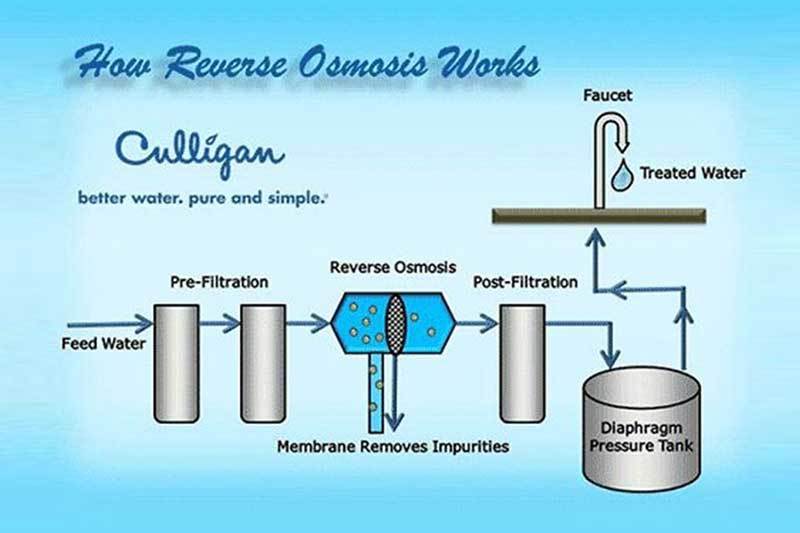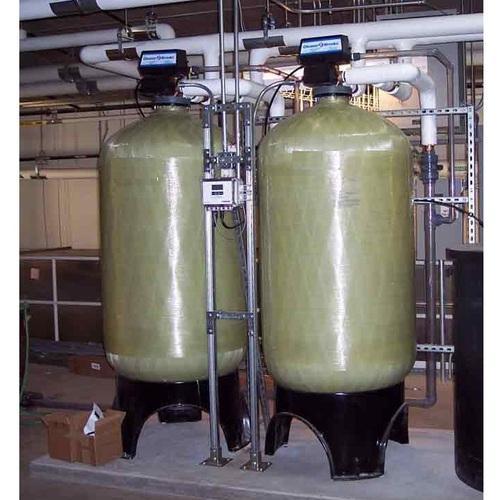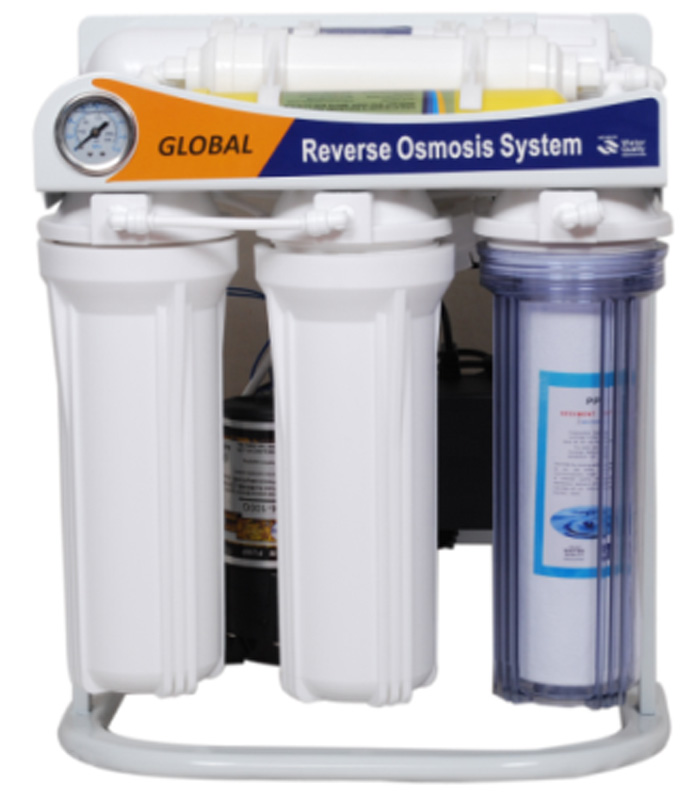
What is a Reverse Osmosis System and How Does it Work?
Reverse Osmosis System: Reverse osmosis removes contaminants from unfiltered water, or feed water, when pressure forces it through a semipermeable membrane. Water flows from the more concentrated side (more contaminants) of the RO membrane to the less concentrated side (fewer contaminants) to provide clean drinking water. The fresh water produced is called the permeate. The concentrated water left over is called the waste or brine.
A semipermeable membrane has small pores that block contaminants but allow water molecules to flow through. In osmosis, water becomes more concentrated as it passes through the membrane to obtain equilibrium on both sides. Reverse osmosis, however, blocks contaminants from entering the less concentrated side of the membrane. For example, when pressure is applied to a volume of saltwater during reverse osmosis, the salt is left behind and only clean water flows through.
How does a Reverse Osmosis system work?
A (RO) system removes sediment and chlorine from water with a pre filter before it forces water through a semipermeable membrane to remove dissolved solids. After water exits the RO membrane, it passes through a postfilter to polish the drinking water before it enters a dedicated faucet. Reverse osmosis systems have various stages depending on their number of pre filters and postfilters.
Does a reverse osmosis system remove…
- Fluoride? Yes.
- Salt? Yes.
- Sediment? Yes.
- Chlorine? Yes.
- Arsenic? Yes.
- VOCs? Yes.
- Herbicides and pesticides? Yes.
- Many other contaminants? Yes. The contaminants listed are some of the most popular ones treated with an RO system, but the system also removes a slew of other contaminants.
- Bacteria and Viruses? No. If your water comes from a city treatment plant, then it should already be microbiologically safe. Reverse osmosis may remove some bacteria, but bacteria could grow on the membrane and potentially enter your water supply. To remove living organisms and viruses, we recommend UV disinfection.
(RO) system benefits
A reverse osmosis system is one of the most extensive methods of filtration. It removes 98% of dissolved solids, which makes it healthier to drink. A water distiller is the only other drinking water system that also reduces TDS, but it’s less efficient than an RO system.
- Harmful dissolved contaminants reduced
- Sodium reduced
- Bad tastes and odors reduced
- More environmentally friendly than bottled water
- Easy to install and maintain
- Fits under the kitchen sink
Does reverse osmosis waste water?
A reverse osmosis system sends water with rejected contaminants down the drain as wastewater, unlike other filters that trap contaminants. As water flows through the system, it’s divided into two streams. One stream carries the filtered water to a dedicated faucet, and the other stream carries the removed salts, dissolved pollutants, and minerals to the drain.
The brine or “wastewater” carries rejected contaminants from a reverse osmosis system to the drain. 4 gallons of water exits the drain for every gallon of water produced. But the brine water is used for a purpose, so it’s not exactly wasted. The wastewater in an RO system helps clean the water, just like a dishwasher uses water to clean dishes or a washing machine uses water to clean clothes. However, it’s our job in caring for the environment to minimize the amount of water sent to the drain and increase the efficiency of the RO system.
How to reduce wastewater in an RO system
- Add a permeate pump. Installing a permeate pump to a reverse osmosis system is the best way to increase its efficiency. Permeate pumps reduce the wastewater from an RO system by 75 to 80%. Not every reverse osmosis system is designed to use one, so make sure the one you choose is plumbed for an additional pump.
- Choose an RO system with an automatic shut off valve. An ASO valve stops the flow of water to the drain once the storage tank is full.
- Use the RO reject water for landscaping or artificial lakes. Drain water has higher levels of total dissolved solids (TDS), but it’s safe to use in your lawn or garden.
The Global 6 Stage Reverse Osmosis (RO) Water Filter is one of the most efficient RO systems
Is reverse osmosis good for the environment?
When the water you use drains from your home, chemicals and other contaminants must be removed before it’s recycled. Wastewater is either sent to a water treatment plant and diluted to make it easier to treat or to riverbeds for nature to filter through the hydrologic cycle.
A reverse osmosis system makes waste treatment more efficient. Reverse osmosis water drained from your home is already free of chemicals since they’ve been removed in the carbon filtration stage. The leftover brine water has just a slightly higher concentration of dissolved inorganics. RO systems speed up the recycling process because no new chemicals are introduced into the water supply after RO water drains from your house.
Reverse osmosis vs. bottled water
Most bottled water is purified through reverse osmosis, but producing bottled water wastes more water than a reverse osmosis system. Think about all the water required to make one bottle of water. When bottled water is purified, wastewater is sent to the drain, and producing the bottle uses water and petroleum. Petroleum is used again to deliver the bottled water to the store. Afterward, the truck may get washed, using even more water. A reverse osmosis system provides water just as pure as bottled water that tastes just as refreshing without as great of a cost to the environment.
Reverse osmosis also has the added benefit of perpetually producing highly purified water in your home. There is no need to run out to the grocery store to stock up on expensive and wasteful cases of bottled water. A reverse osmosis system produces bottled water quality hydration in the comfort of your kitchen. You can even fill stainless steel water bottles with RO water and store them in your fridge, so you can enjoy all the conveniences of bottled water without the disposable single-use plastic bottles and weekly grocery runs.
Is reverse osmosis water good for you?
A reverse osmosis water system removes dissolved contaminants that you can’t see but that could make you sick. Reverse osmosis does work for your kidneys by filtering water before it enters your body. It also removes beneficial minerals like calcium and magnesium from water, but that does not make reverse osmosis water bad for you.
Our bodies are 70-80% water that hydrates, lubricates joints, and aids organ function. You don’t need minerals to do those things. You would have to drink excessive amounts of water for your body to absorb enough mineral content to make a significant difference. Food is the primary source of essential nutrients, not water. If you want more minerals, eat your fruits and veggies.
Some mineral content is fine to drink, but the EPA recommends that the amount of TDS in water not exceed 500 parts per million. A large portion of the U.S. has TDS levels that exceed this level and could benefit from an RO system.


Where to use a (RO) system
For the whole house? Rarely.
Reverse osmosis can be used to treat water for the whole house. However, unless your water has a specific contaminant that requires reverse osmosis, using an RO system may be over-kill. An RO system solves specific problems like saltwater intrusion in a well or high levels of silica in the water.
An RO system will not provide the flow rate needed to pressurize an entire house. In the rare case where a whole house requires RO water, a large booster pump, like a Grundfos or Davey, provides adequate water pressure. In addition to a large water pump and storage tank, a UV system is needed to disinfect the water once it leaves the tank.
Homeowners have a lot to consider when purchasing an RO system for the whole house. If your water quality is dire enough to warrant whole house reverse osmosis, you likely have other water quality issues that will need to be addressed prior to the water reaching the RO membrane. High levels of water hardness will cause scale build-up on the membrane, reducing its performance and causing it to fail prematurely. Contaminants like iron can also foul the membrane and will need to be eliminated from the water before being treated by the reverse osmosis system.
If you believe your water quality may require whole house reverse osmosis to treat, check out our in-depth guide on whole-house reverse osmosis systems. | Explore how water booster pumps work.
For showers? No.
If you don’t want to purchase a storage tank larger than your basement, reverse osmosis is not the best option for your shower. The solution is usually much simpler and more focused than reverse osmosis. Shower water with high levels of chloramines can cause nose and eye irritation and aggravate skin conditions. Chloramines are best removed by a whole house catalytic carbon filter.
Hard water can also lead to unsatisfying showers. Soap does not lather well in water with elevated mineral content, and hard water can leave hair feeling lifeless and dull. An ion exchange water softener will eliminate these contaminants.
Under the sink? Yes.
Reverse osmosis is most commonly installed at the point of use (POU), like under a kitchen or bathroom sink. A point-of-use RO system could also be mounted in a cabinet or remotely in the garage or basement.
For a refrigerator? Yes.
Connecting an under-sink reverse osmosis system to your refrigerator is simple and worthwhile. Reverse osmosis removes minerals from water, making your ice clear and beverages more refreshing.
For pools? No.
The only time you may need an RO system for a pool is if the water contains some contaminant that no other filtration system can remove. If you try to fill a 20,000-gallon pool with RO water, even with the most efficient system, you will send 10,000 gallons down the drain. Good news: the amount of dissolved solids in a pool doesn’t really matter, so other systems do a better job providing clean pool water.
For agriculture? Sometimes.
Reverse osmosis works well for hydroponic farming, but not all plants survive or thrive with RO water. RO is best suited for greenhouses where plants are misted or in small gardens, depending on the types of plants. Since hydroponic farming eliminates soil, and instead nurtures fruits and flowers with only nutrient-rich water, high-quality water is paramount to hydroponic success. Even small amounts of sediments, salts, and dissolved organics can upset the delicate balance of the plant life. RO water allows for total control over your plants nutrient intake.
Explore how to use reverse osmosis water for hydroponics. | Learn more about how hydroponic systems work.
For wells? Yes.
If you get your drinking water from a private well, then an RO system is an excellent way to ensure that the water flowing to your tap is safe. A reverse osmosis system is a perfect way to remove difficult contaminants often found in well water, like nitrates.
In apartments? No.
One point-of-entry unit usually supplies water to an apartment building or condominium, and installing an under-sink system is often not allowed. A countertop filter system is the best option in an apartment.
| If you’re looking to invest in a countertop filter, explore our countertop filter buyer’s guide. |
At businesses? Yes.
Commercial or industrial reverse osmosis systems are common because commercial units allow drain water to be sent back into the feed supply. Reverse osmosis removes paints, dyes, and other industrial contaminants well.
For an aquarium? Yes.
If you’re a saltwater fish enthusiast, then an RO system is perfect for you. Reverse osmosis allows you to strip all minerals from the water and add exactly the amount of salt you need back in with a remineralizing filter. Most aquarists rely on a combination of reverse osmosis and deionization (known as RO/DI water) to ensure their fish are immersed in highly pure water, modified to match the fish’s natural environment.
| Learn more about why you should use reverse osmosis water in your aquarium. |
In RVs? Yes.
RO systems require proper draining. Storage tanks are difficult to attach to RVs because drain hookups aren’t located at campsites, but it is possible. A reverse osmosis system can be very helpful for those whose RV adventures take them into more remote, wilderness locations. A combination of RO and ultraviolet disinfection can make sure the water you are drinking is free from harmful bacteria and particulate matter.
| Explore our RV water filters buyer’s guide. |
RO system vs. a water softener
Unlike a reverse osmosis system, a water softener does not filter harmful contaminants from water. It removes calcium and magnesium to soften hard water and make washing clothes and showering easier.
Water is softened during reverse osmosis. However, using a reverse osmosis system to treat hard water (above 7 grains) shortens the life of the RO membrane. This will lead to more frequent membrane replacements. If you have hard water, use a water softener to treat it instead.
Reverse osmosis systems and water softeners benefit each other. A water softener installed before the RO system removes iron from the water that can stain your shower, clothes, and toilet orange and clog the RO membrane. An RO system removes sodium added by the water softener.
Learn more about how water softeners work.




Reverse osmosis systems for the home
Residential reverse osmosis systems are one of the best ways to filter your drinking water. Here are our three best-selling reverse osmosis systems:
Residential reverse osmosis systems are one of the best ways to filter your drinking water. Here are our two best-selling reverse osmosis systems:

